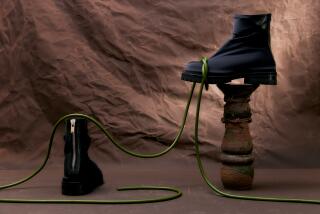Perfume Equals Part Mystery, Part Marketing
- Share via
People in the perfume industry like to say they’re selling mystery, luxury and fashion.
No contest. Any scented liquid costing more than $100 an ounce is certainly a luxury. It’s also clearly subject to fashion: Most top perfumes come from fashion designers, and the best-sellers change. Old standards such as Chanel No. 5, Shalimar and White Shoulders stay around, but the big hits are new--Giorgio, Oscar de la Renta, Dior’s Poison, Calvin Klein’s Obsession, among others.
Perfume is certainly mysterious. People buying such fragrances rarely know the strength or comparative value. Some guess that the difference between expensive and cheap perfume is real flower oils rather than synthetics. Others know that “perfume”--the industry’s word for the strongest concentration--is stronger than cologne, but have no idea about eau de parfum , toilet water or splash.
Maybe no one cares. Perfumes in liquid form (not soaps, powders, deodorants) are worth $3.7 billion a year now at retail, according to Kline & Co., a New Jersey marketing consultant. Women’s scents, in all their strengths and brands, account for $2.6 billion of that.
Indeed, perfumes, for all their mystery and luxury, are mass market: 50% of the dollar volume comes from drugstores and chains and only 30% from department stores. Cologne--the lowest price category--is by far the most popular strength. One hypothesis is that today’s women buy more perfume themselves, instead of waiting for gifts. Moreover, more women work and can afford it, and working women are more likely to wear it.
Wider Choice
The basic solution is always ethyl alcohol, water and fragrance oils: Price differences are only sometimes dependent on the quality or rarity of those oils, which may be extracted from flowers or and other plants, or synthetically produced. Actually, all perfumes include some synthetics, or “aroma chemicals,” in industry jargon. “Almost any natural material can be duplicated,” says Eleanor Fox, vice president of International Flavors & Fragrances in New York, an industry supplier. Some have to be, because perfumers have “never been able to extract the essential oils from some flowers--lilac and lily of the valley, for example.”
Scents labeled “perfume” are traditionally the most concentrated--10% to 25% fragrance--and colognes the weakest, with 5% to 7% fragrance. But the growing market became as crowded with choices as brands: one can now have perfume, eau de parfum, esprit de parfum, eau de toilette, eau de cologne, splash and more.
Overall, everything’s stronger now in scent and concentration: Perfumes are 20% to 35% fragrance, toilet waters and colognes 10% to 25%, and only “splashes,” like men’s colognes and after-shaves, less than 10% fragrance.
No Rule Book
The pop explanation for this strengthening is that women are more assertive: “People seem to want more noticeable fragrances,” says John F. Doyle, senior vice president, perfumery, for Roure, a Teaneck, N.J., supplier. Given the crowded field, marketers may also be more assertive.
But there are no rules or regulations, and a product’s concentration, whatever it’s called, is up to the marketers. In this country they don’t tell the consumer what she’s buying: Labels on perfume bottles needn’t reveal strength. They could, of course: Perfumes sold in France state the alcohol concentration in percentage or degree--”84% volume” or “84 degrees.”
Whatever its composition, the bottle’s contents are a minimum component of the price. Perfumes are thus more typical of packaged goods (cereals, cake mixes) than of clothing.
“With a designer perfume, the cost of the goods--’juice,’ bottle, cap, label and box--might be 15% to 20% of the wholesale price and maybe a 10th of the retail,” says W. Edward Sanford, president of Westport Laboratories in Fairfield, Conn., which makes “alternative” perfumes. The rest is marketing, sales costs, and profit, and later, the retailer’s markup.
Designer perfumes are rarely discounted while popular, and marketers have close control of distribution.
“They might limit distribution to a small number of accounts,” says Sanford, “or to one in a market, an exclusive. And while retailers can sell something for whatever they want, selling it below the suggested retail is antithetical to their business of providing fashion rather than price-cutting.”
Designer fragrances are copied, however, and knockoffs sell for half the price of the original, or less. Three ounces of Giorgio spray cologne retails for $45, three ounces of Primo, a successful imitator, for $8 an ounce (“If you like Giorgio, you’ll love Primo”). One can also buy Juliano instead of Giorgio, Fatal instead of Poison, Raw Silk instead of White Linen, Lindsay instead of Lauren.
Not Always the Same
All this is possible because perfume formulas are, says Doyle, “secret but not protected.” Companies can trademark only the name and a demonstrably unique package--the yellow and white awning-striped Giorgio box, for example.
What’s more, a scent can be duplicated with equal quality, says Mark Laracy, president of Parfums de Coeur in Stamford, Conn., which makes Primo and other imitators. “We spend as much per ounce as Giorgio on the juice,” says Laracy, but only a third as much on advertising and promotion.
Others say that without the exact formula, an imitation can only smell like the original. Some don’t even come close--the mail-order samplers of famous perfume “versions,” for example. Even good imitations are recognizably different, as their makers concede. Sanford says Westport fragrances are purposely “a bit softer, not as cloying or overpowering” as the originals, and Laracy positions his fragrances as “interpretations” of hit perfumes that are “actually better than the originals.”
Some designer brands have sued--over name, or claim or packaging. Others have just swallowed it. After all, says Laracy, “imitation has been fundamental in the perfume business,” if less outspoken.
“It’s an annoyance (to designer brands) that somebody’s getting a free ride on their marketing efforts,” says Sanford, “but as long as they price their products absurdly high, they create that opportunity. If they dropped their prices from $25 to $12.50 for an ounce of cologne, they’d wipe us out.”






